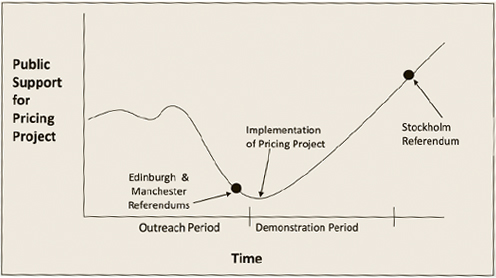The first time Donald Trump was elected president, in 2016, Washington State residents also voted down an initiative that would have created the country’s first statewide carbon tax.
The second time Trump won the presidency, last week, Washington residents flipped their 2016 stance on carbon pricing, voting to preserve the comprehensive carbon pricing program that their legislature ended up enacting. And therein lies a message for New York Gov. Kathy Hochul, who paused the central business district tolling on June 5, just as it was about to go into effect after years of debate.
The message: If the policy is wise, stay the course. The facts on the ground will soon change, generating the political support to validate your policy and prepare you for the next policy battle.

Congestion pricing proponents have always known the odds. Taxes are unpopular, check. Driving is a birthright and change is hard, check. We were aware congestion pricing in London and Stockholm had only 40 percent favorability before adoption. But both cities’ experience showed that once traffic visibly lessened and transit improvements got underway, opinion flipped. Roughly 60 percent of residents now support the tolls.
The 2016 vote against Washington carbon pricing was a landslide: 59.3 percent no to 40.7 percent yes. The 2024 vote to keep the state’s carbon pricing law was a landslide in the opposite direction: 62 percent to keep it and 38 to repeal it. Hmm, looks like that 60-40 rule has legs!
A brief look at the law that Washington State voted to keep last week will demonstrate how it’s cut from the same cloth as New York’s congestion pricing.
Washington’s innovative Climate Commitment Act requires fossil fuel companies to buy permits keyed to the carbon content of their fuels. That includes oil refineries, which pass on the costs of the permits to motorists and homeowners as higher prices for gasoline and heating fuels.
The intent is to motivate industry and consumers to curb their carbon dependence, much like congestion pricing in New York would impel motorists to drive less often into gridlocked Manhattan. Sales of the emission permits in Washington are already helping finance electrification and renewable-energy substitutes for fossil fuels, just as New York’s congestion revenues would have bankrolled $15 billion in better transit.
And just as it has been in New York, the road to this decision wasn’t easy. Washington’s climate law took root after voters twice rejected ballot referendums for statewide pricing of carbon emissions by margins of around 60 to 40. (A 2018 initiative failed as well, 56.6 percent to 43.3percent.) But after Democrats won control of the legislature in 2020, Gov. Jay Inslee, a Democrat and unabashed climate champion, pushed through the Climate Commitment Act, much as New York Gov. Andrew Cuomo in 2019 won legislation directing the regional transit authority to institute a congestion pricing system.
This year, however, fossil fuel backers in Washington collected enough signatures to place Initiative 2117on the Nov. 5 ballot. A “yes” vote would have repealed the legislation and discarded the emission permits — perhaps slowing energy price increases but stalling the state’s shift toward clean power.
Well, the returns are in, and supporters of the emissions permit scheme won big.
True, what was on the ballot in Washington last week — making gasoline and other fossil fuels more costly to elevate lower-emission substitutes from smaller cars to electric cars and, best of all, less driving — isn’t the same as congestion pricing. But it’s a close cousin. What stands out is that a policy rejected by nearly 60 percent of voters in 2016 and again in 2018, won with around 60 percent in 2024. Attitudes can shift when facts warrant.
What enabled the turnaround? A resolute governor stayed the course, allowing the “default” to recalibrate from cheap gas to clean power and letting the public warm to this novel policy for cutting carbon pollution. Once it did, 20 percent of voters came aboard, just like they did in London and Stockholm.
New York hasn’t been as fortunate yet. This spring, our executive gazed at the pending $15 peak congestion toll and rather than seeing less gridlock and a transformed transit system, saw a political abyss. Advocates and even her own staff tried to brace her for this “valley of political death” between congestion pricing’s initiation and its eventual acceptance. The warnings did no good. On June 5, she placed the tolls on “indefinite pause.”
There is talk that the governor will soon un-pause the tolls now that the suburban House races she feared would be swept up in a congestion pricing backlash are decided. But Gov. Hochul must move with urgency. The incoming president has made his distaste for the tolls abundantly clear. His return to power is less than 10 weeks away, with at least four of those weeks likely gobbled up by red tape. The plan’s logic that Hochul herself once articulated so well remains intact: better commutes and healthier, safer streets.
Hochul must act fast and trust the message from Washington State: with strong leadership, good policy and good politics can be one and the same.






